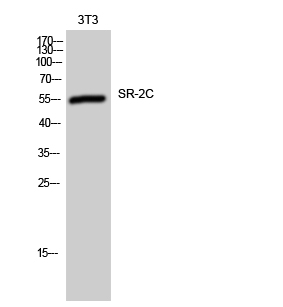SR-2C Polyclonal Antibody
- Catalog No.:YT4399
- Applications:WB;IHC;IF;ELISA
- Reactivity:Human;Mouse;Rat
- Target:
- SR-2C
- Fields:
- >>Calcium signaling pathway;>>Neuroactive ligand-receptor interaction;>>Gap junction;>>Serotonergic synapse;>>Inflammatory mediator regulation of TRP channels
- Gene Name:
- HTR2C
- Protein Name:
- 5-hydroxytryptamine receptor 2C
- Human Gene Id:
- 3358
- Human Swiss Prot No:
- P28335
- Mouse Gene Id:
- 15560
- Mouse Swiss Prot No:
- P34968
- Rat Gene Id:
- 25187
- Rat Swiss Prot No:
- P08909
- Immunogen:
- The antiserum was produced against synthesized peptide derived from human 5-HT-2C. AA range:161-210
- Specificity:
- SR-2C Polyclonal Antibody detects endogenous levels of SR-2C protein.
- Formulation:
- Liquid in PBS containing 50% glycerol, 0.5% BSA and 0.02% sodium azide.
- Source:
- Polyclonal, Rabbit,IgG
- Dilution:
- WB 1:500 - 1:2000. IHC 1:100 - 1:300. IF 1:200 - 1:1000. ELISA: 1:5000. Not yet tested in other applications.
- Purification:
- The antibody was affinity-purified from rabbit antiserum by affinity-chromatography using epitope-specific immunogen.
- Concentration:
- 1 mg/ml
- Storage Stability:
- -15°C to -25°C/1 year(Do not lower than -25°C)
- Other Name:
- HTR2C;HTR1C;5-hydroxytryptamine receptor 2C;5-HT-2C;5-HT2C;5-HTR2C;5-hydroxytryptamine receptor 1C;5-HT-1C;5-HT1C;Serotonin receptor 2C
- Observed Band(KD):
- 55kD
- Background:
- This gene encodes a seven-transmembrane G-protein-coupled receptor. The encoded protein responds to signaling through the neurotransmitter serotonin. The mRNA of this gene is subject to multiple RNA editing events, where adenosine residues encoded by the genome are converted to inosines. RNA editing is predicted to alter the structure of the second intracellular loop, thereby generating alternate protein forms with decreased ability to interact with G proteins. Abnormalities in RNA editing of this gene have been detected in victims of suicide that suffer from depression. In addition, naturally-occuring variation in the promoter and 5' non-coding and coding regions of this gene may show statistically-significant association with mental illness and behavioral disorders. Alternative splicing results in multiple different transcript variants. [provided by RefSeq, Jan 2015],
- Function:
- domain:The PDZ domain-binding motif is involved in the interaction with MPDZ.,function:This is one of the several different receptors for 5-hydroxytryptamine (serotonin), a biogenic hormone that functions as a neurotransmitter, a hormone, and a mitogen. This receptor mediates its action by association with G proteins that activate a phosphatidylinositol-calcium second messenger system.,polymorphism:Position 23 is polymorphic; the frequencies in unrelated Caucasians are 0.87 for Cys and 0.13 for Ser.,PTM:N-glycosylated.,RNA editing:Partially edited. RNA editing generates receptor isoforms that differ in their ability to interact with the phospholipase C signaling cascade in a transfected cell line, suggesting that this RNA processing event may contribute to the modulation of serotonergic neurotransmission in the central nervous system.,similarity:Belongs to the G-protein coupled receptor
- Subcellular Location:
- Cell membrane ; Multi-pass membrane protein .
- Expression:
- Detected in brain.
- June 19-2018
- WESTERN IMMUNOBLOTTING PROTOCOL
- June 19-2018
- IMMUNOHISTOCHEMISTRY-PARAFFIN PROTOCOL
- June 19-2018
- IMMUNOFLUORESCENCE PROTOCOL
- September 08-2020
- FLOW-CYTOMEYRT-PROTOCOL
- May 20-2022
- Cell-Based ELISA│解您多样本WB检测之困扰
- July 13-2018
- CELL-BASED-ELISA-PROTOCOL-FOR-ACETYL-PROTEIN
- July 13-2018
- CELL-BASED-ELISA-PROTOCOL-FOR-PHOSPHO-PROTEIN
- July 13-2018
- Antibody-FAQs
- Products Images

- Western Blot analysis of 3T3 cells using SR-2C Polyclonal Antibody

- Immunofluorescence analysis of A549 cells, using 5-HT-2C Antibody. The picture on the right is blocked with the synthesized peptide.

- Immunohistochemistry analysis of paraffin-embedded human brain tissue, using 5-HT-2C Antibody. The picture on the right is blocked with the synthesized peptide.


